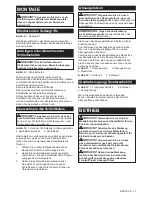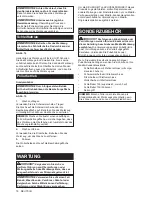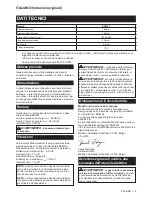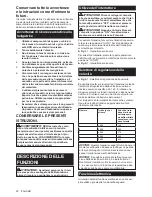
5
ENGLISH
Save all warnings and instruc-
tions for future reference.
The term "power tool" in the warnings refers to your
mains-operated (corded) power tool or battery-operated
(cordless) power tool.
Sander safety warnings
1.
Always use safety glasses or goggles.
Ordinary eye or sun glasses are NOT safety
glasses.
2.
Hold the tool firmly.
3.
Do not leave the tool running. Operate the tool
only when hand-held.
4.
This tool has not been waterproofed, so do not
use water on the workpiece surface.
5.
Ventilate your work area adequately when you
perform sanding operations.
6.
Some material contains chemicals which may
be toxic. Take caution to prevent dust inhala
-
tion and skin contact. Follow material supplier
safety data.
7.
Use of this tool to sand some products, paints
and wood could expose user to dust contain
-
ing hazardous substances. Use appropriate
respiratory protection.
8.
Be sure that there are no cracks or breakage
on the pad before use. Cracks or breakage
may cause a personal injury.
SAVE THESE INSTRUCTIONS.
WARNING:
DO NOT let comfort or familiarity
with product (gained from repeated use) replace
strict adherence to safety rules for the subject
product. MISUSE or failure to follow the safety
rules stated in this instruction manual may cause
serious personal injury.
FUNCTIONAL
DESCRIPTION
CAUTION:
Always be sure that the tool is
switched off and unplugged before adjusting or
checking function on the tool.
Switch action
CAUTION:
Before plugging in the tool, always
check to see that the slide switch actuates prop
-
erly and returns to the "OFF" position when the
rear of the slide switch is depressed.
CAUTION:
When locking tool in "ON" position
apply caution and maintain firm grasp on tool.
To start the tool, slide the slide switch toward the "I
(ON)" position. For continuous operation, press the
front of the slide switch to lock it.
►
Fig.1:
1. Slide switch
To stop the tool, press the rear of the slide switch, then
slide it toward the "O (OFF)" position.
►
Fig.2:
1. Slide switch
Speed adjusting dial
►
Fig.3:
1. Speed adjusting dial
The rotating speed can be changed by turning the
speed adjusting dial to a given number setting from 1 to
5. Higher speed is obtained when the dial is turned in
the direction of number 5. And lower speed is obtained
when it is turned in the direction of number 1.
Refer to the table for the relationship between the num-
ber settings on the dial and the approximate rotating
speed.
Number
Orbits per min.
Pad rotating
speed per minute
in random orbit
with forced rota-
tion mode
1
1,600
140
2
2,900
260
3
4,200
370
4
5,500
490
5
6,800
600
NOTICE:
If the tool is operated continuously at low
speeds for a long time, the motor will get overloaded,
resulting in tool malfunction.
NOTICE:
The speed adjusting dial can be turned
only as far as 5 and back to 1. Do not force it past 5
or 1, or the speed adjusting function may no longer
work.
Electronic function
The tools equipped with electronic function are easy to
operate because of the following features.
Constant speed control
Possible to get fine finish, because the rotating speed is
kept constant even under the loaded condition.
Soft start feature
Soft start because of suppressed starting shock.
Selecting the action mode
Use the change knob to change the rotation mode.
NOTICE:
Always turn the knob fully. If the knob is in
the middle position, you can not turn on the tool.
NOTE:
You can not change the action mode when the
tool is switched on.
Random orbit with forced rotation
mode
►
Fig.4:
1. Change knob
Random orbit with forced rotation mode is orbital action
with forced rotation of the pad for rough sanding and
polishing.






































